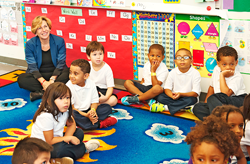The True Story of Public Education in America
You’ve heard their mantra: Our public schools are failing because teachers don’t care and policymakers are spending too much money to prop up a broken system. Campbell Brown and company, who could be called Michelle Rhee 2.0, have carried on this refrain. They say it’s the teachers who are holding back our nation’s neediest kids.
While this narrative is infuriating, what’s more important are the legions of classrooms that debunk it. Over the past month, I’ve visited some of these classrooms Connecticut, Massachusetts, Ohio, Texas and Washington, D.C. – they hum with life as teachers engage students from all demographics and geographies. You can see the joy of learning.
At Middle College High School in Houston, Texas, students who had been on the verge of dropping out tell me how they had little hope but now have dreams for the future. Thanks to dedicated teachers and school support staff, a great principal, and community partnerships, these students are met where they are and have access to the individual support they need to move forward—things like a later start time, food that’s always available and smaller class sizes. And the students have each other’s backs. One student told me that if he doesn’t see his classmates at the bus stop in the morning, he calls to check in on them.
At Fair Haven Elementary School in New Haven, Connecticut, teachers describe an atmosphere of trust and collaboration. Martina Ramos, a kindergarten teacher who was struggling, tells me how, instead of being thrown out, she got thesupport she needed to improve. “I definitely feel more confident when I walk into the classroom,” she shared. “I’m strong, I’m competent, I know what I’m going to teach and I know I’m going to see results in my students. I honestly think that if I did not have those supports in place, I don’t think I would be teaching at this point.”
At Oliver School in Lawrence, Mass., in a district that many wanted to charterize following the New Orleans model, Superintendent Jeff Riley instead worked with our union to create a labor-management partnership that has led to increased planning and professional-development time for teachers and vital wraparound services for students and their families. And all the signs show real success for kids. “I'm proud that we are an AFT-unionized district,” Riley said. “We are all working for one thing and that's the kids.”
This same story is playing out in public schools across America.
But don’t take my word for it. While we will never be satisfied until all our kids reach their potential, there’s evidence we are moving forward. The latest PDK/Gallup poll shows that 67 percent of public school parents give their child’s school a grade of A or B. And 6 in 10 public school parents say their child’s school supports high levels of well-being, while more than half believe it encourages their child to build strong relationships. What’s more, a resounding majority of Americans disagree with the naysayers’ belief that student test scores should determine whether a teacher is a success or failure.
Instead of starving our schools of critical funding and pushing market-based, test-driven policies that ultimately fail our kids, we should be relying on evidence and input from those closest to the classroom to find solutions that work to reclaim the promise of public education.
Public education should help students build positive relationships with their peers and with adults. It should help them not only to acquire knowledge but to think critically and apply what they’ve learned. It should help students develop persistence and grit. And it should foster joy as they learn.
Take what happened in New Haven. A few years back, teachers and their union were at loggerheads with the district. Both sides decided that the continued acrimony wasn’t helping New Haven’s children. We set aside our differences, began to build trust, and, now, collaboration is embedded in the school culture. And we are seeing results: Graduation rates are up, drop out rates are down, and test scores are steadily improving.
When we work together – to fix, not close, neighborhood schools, to give kids the critical-thinking and problem-solving skills they need to succeed in our 21st-century economy and the support they need to address their economic and social challenges, when we trust and support teachers – we can succeed.
There is no silver bullet. We still have a lot of work to do to ensure that every child in America has access to a high-quality public education. But, despite what our detractors would have you believe, great, welcoming public schools are within our grasp.
How do I know? Because I’ve seen it.
I challenge others, who have not spent any real time in these classrooms, to see this too, before they try to substitute their judgment for the judgment of those closest to our kids – their parents and their teachers.

